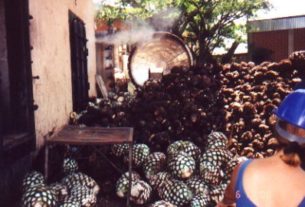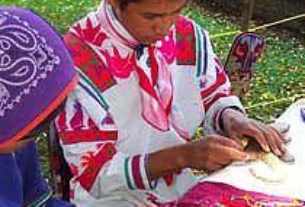The transition from childhood to womanhood is a significant passage for adolescent girls in almost all cultures. In Mexico, it is marked with the celebration of the Quinceañera, or 15th Birthday. From a north-of-the-border viewpoint, it may be seen as a cross between Sweet Sixteen and a debutante’s coming out party. The celebration is a way to acknowledge that a young woman has reached sexual maturity and is thus of a marriageable age.
The most important component of the celebration is invariably a Misa de acción de gracias (thanksgiving Mass). The birthday girl arrives decked out in a fancy full-length dress – frills, pastel tones and matching hats or headdresses prevail. Flanked by her parents and padrinos (godparents), she is specially seated at the foot of the altar throughout the service. She may be accompanied by up to seven damas (maids of honor) and as many chambelanes (chamberlains), selected from among close family and friends.

At the end of the mass younger sisters, cousins and friends pass out bolos (commemorative favors) to those in attendance, while the quinceañera deposits her bouquet on the altar or in a niche honoring the Virgin Mary, most often that of the ubiquitous Virgen de Guadalupe.
The quinceañera traditionally has the option of further celebrating the occasion with either a viaje (journey) or a fiesta (birthday bash). While a trip to Paris and other European destinations was once the rage among the well-heeled, nowadays young women of all social strata generally opt for the party, complete with live band music. The degree of opulence of the event is directly related to the economic means of the girl’s parents and godparents.
Urbanites frequently lease banquet halls for the dance, while village folks are more inclined to set up rented folding tables and chairs in a freshly cleared and swept huerta (orchard) or corral. To cover the multiple expenses, a host of padrinos and madrinas may be invited to sponsor, respectively, the dress, the music, the locale, the bar, the cake and the table favors.
While raucous banda, cumbia and salsa tunes tend dominate throughout the event, the culminating moment comes when the festejada (celebrant) and her number-one chambelán (escort) dance to a traditional waltz. Other indispensable highlights include a customary toast and the cutting of a multi-tiered birthday cake. Dripping in meringue frosting and decorated in hues to match the quinceañera’s dress, the cake may be of such monumental proportions that the door leading into the party locale must be removed from it hinges.to accommodate it!
The origins of Mexico’s quinceañera celebrations remain obscure, although the roots may well lie in the era of the Aztecs. According to Bernardino de Sahagun, in his chronicle Historia de Nueva España, it was traditional for the parents of a young Aztec maiden to formally acknowledge her passage into womanhood. This included a stern but tender exhortation to observe acceptable modes of behavior. For a full English translation of the passage “Advice of an Aztec Mother to her Daughter” see William H. Prescott’s The Conquest of Mexico.
Regardless of how the tradition originated, regardless of the relentless onslaught of gringo culture prevalent today, the celebration of the quinceañera remains as one of the rites of passage that keeps the bonds of the Mexican family firmly cemented. Its fancy frills and frosting abide as rich ingredients for a niña’s sweet dreams.
Other customs:
Weddings:
- Romantic Weddings South Of The Border
- Charro Wedding in a Small Mexican Town
- A wedding and christening in rural Oaxaca: The mandate of tradition
- Mexican Wedding Feasts: La Comida de la Boda
- The wedding – an excerpt from the book: Agave Marias



This is some great stuff
Love this. My little princess will love this.
Thank you for the historical aspects of the tradition. This tradition has a downside that parents do not discuss with their kids. Females face social pressure and assimilation influences to marry and have kids in their teens. The young males see this tradition as confirmation that “she is available”.